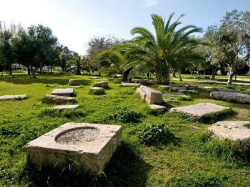Academy of Plato

Academy of Plato
This was a place of dwelling from the prehistoric time until the 6th Century A.D. during which one of the three same named Gymnasiums of Athens was established in the area.
It has been noted that Peisistratidis Hippias built the actual grounds, while Cimon planted the trees in the area – the latter whose work was continued in 86 B.C. by Sulla. In 387 B.C., Plato founded his renowned school that took the same name as his and was met with great acclaim by Neo-Plato-nites for it to see its final closure at the hands of Justinian in 529 B.C..
The Sacred Residence of Geometric times
It consists of seven (rectangular shaped) spaces with one hall at both sides. The structure exhibits many common elements with the sacred residence of Eleusis. Judging from the remains of sacrifices found in the area, it has been theorized that it was used many times for the purposes of worship.
The Gymnasium
A large rectangular building with an interior colonnade and rooms to the northern side. Inside, there is also another, smaller space intended as a wrestling ring.
(1st Century B.C. – 1st Century A.D.)
The Colonnade Building
A large building with an interior colonnade. Some think it was a wrestling ring while others think it was an annex to the Gymnasium.
(4th Century B.C.)
The early Helladic Vaulted Residence
It consists of an entrance-way, main chamber and a storage room. It has been theorized that this was the prehistoric residence of Akadimus.








